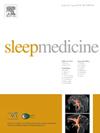Machine-learning-based classification of obstructive sleep apnea using 19-channel sleep EEG data
IF 3.8
2区 医学
Q1 CLINICAL NEUROLOGY
引用次数: 0
Abstract
Objective
This study aimed to investigate the neurophysiological effects of obstructive sleep apnea (OSA) using multi-channel sleep electroencephalography (EEG) through machine learning methods encompassing various analysis methodologies including power spectral analysis, network analysis, and microstate analysis.
Methods
Twenty participants with apnea-hypopnea index (AHI) ≥ 15 and 18 participants with AHI <15 were recruited. Overnight polysomnography was conducted concurrently with 19-channel EEG. Preprocessed EEG data underwent computation of relative spectral power. A weighted network based on graph theory was generated; and indices of strength, path length, eigenvector centrality, and clustering coefficient were calculated. Microstate analysis was conducted to derive four topographic maps. Machine learning techniques were employed to assess EEG features capable of differentiating two groups.
Results
Among 71 features that showed significant differences between the two groups, seven exhibited good classification performance, achieving 88.3 % accuracy, 92 % sensitivity, and 84 % specificity. These features were power at C4 theta, P3 theta, P4 theta, and F8 gamma during NREM1 sleep and at Pz gamma during REM sleep from power spectral analysis; eigenvector centrality at F7 gamma during REM sleep from network analysis; and duration of microstate 4 during NREM2 sleep from microstate analysis. These seven EEG features were significantly correlated with polysomnographic parameters reflecting the severity of OSA.
Conclusions
The application of machine learning techniques and various EEG analytical methods resulted in a model that showed good performance in classifying moderate to severe OSA and highlights the potential of EEG to serve as a biomarker of functional changes in OSA.
使用 19 通道睡眠脑电图数据对阻塞性睡眠呼吸暂停进行基于机器学习的分类。
研究目的本研究旨在通过机器学习方法,包括功率谱分析、网络分析和微状态分析等各种分析方法,利用多通道睡眠脑电图(EEG)研究阻塞性睡眠呼吸暂停(OSA)对神经生理的影响:方法:20 名呼吸暂停-低通气指数(AHI)≥ 15 的参与者和 18 名呼吸暂停-低通气指数(AHI)结果:在两组之间有显著差异的 71 个特征中,有 7 个表现出良好的分类性能,准确率达到 88.3%,灵敏度达到 92%,特异性达到 84%。这些特征包括:功率谱分析得出的 NREM1 睡眠期间 C4 theta、P3 theta、P4 theta 和 F8 gamma 处的功率,以及 REM 睡眠期间 Pz gamma 处的功率;网络分析得出的 REM 睡眠期间 F7 gamma 处的特征向量中心性;微状态分析得出的 NREM2 睡眠期间微状态 4 的持续时间。这七个脑电图特征与反映 OSA 严重程度的多导睡眠图参数有明显相关性:应用机器学习技术和各种脑电图分析方法建立的模型在对中度至重度 OSA 进行分类方面表现良好,并突出了脑电图作为 OSA 功能变化生物标志物的潜力。
本文章由计算机程序翻译,如有差异,请以英文原文为准。
求助全文
约1分钟内获得全文
求助全文
来源期刊

Sleep medicine
医学-临床神经学
CiteScore
8.40
自引率
6.20%
发文量
1060
审稿时长
49 days
期刊介绍:
Sleep Medicine aims to be a journal no one involved in clinical sleep medicine can do without.
A journal primarily focussing on the human aspects of sleep, integrating the various disciplines that are involved in sleep medicine: neurology, clinical neurophysiology, internal medicine (particularly pulmonology and cardiology), psychology, psychiatry, sleep technology, pediatrics, neurosurgery, otorhinolaryngology, and dentistry.
The journal publishes the following types of articles: Reviews (also intended as a way to bridge the gap between basic sleep research and clinical relevance); Original Research Articles; Full-length articles; Brief communications; Controversies; Case reports; Letters to the Editor; Journal search and commentaries; Book reviews; Meeting announcements; Listing of relevant organisations plus web sites.
 求助内容:
求助内容: 应助结果提醒方式:
应助结果提醒方式:


